19世纪中期俄国批判现实主义作家
列夫托尔斯泰作品好段摘抄

列夫托尔斯泰作品好段摘抄导语:列夫·尼古拉耶维奇·托尔斯泰(1828年9月9日-1910年11月20日)19世纪中期俄国批判现实主义作家、思想家,哲学家。
代表作有《战争与和平》、《安娜·卡列尼娜》、《复活》等。
人并不是因为美丽才可爱,而是因为可爱才美丽。
——托尔斯泰《安娜·卡列尼娜》我们都在等待,等待着别的人来拯救我们自己。
——列夫·托尔斯泰《安娜·卡列尼娜》幸福的家庭有同样的幸福,而不幸的家庭则各有各的不幸。
——托尔斯泰《安娜·卡列尼娜》人都是为希望而活,因为有了希望,人才有生活的勇气。
——列夫·托尔斯泰《安娜·卡列尼娜》风中之烛在风中摇曳,微弱的亮光照亮四周,最终在黑暗之中黯然消逝。
——列夫·托尔斯泰《安娜·卡列尼娜》水满则溢,说盈则亏”,这个世界从来只有更美,而没有最美。
而最靠近完美的一刻,就是最容易走向相反的时刻。
——列夫·托尔斯泰《安娜·卡列尼娜》幸福的家庭都是相似的;不幸的家庭各有各的不幸。
——列夫·托尔斯泰《安娜·卡列尼娜》幸福的人都是一样的,不幸的人各有各的不幸。
——列夫·托尔斯泰《安娜卡列尼娜》由此可知,上帝是一个禁欲主义者。
他不允许别人干他不喜欢的事,因此他又是一个独裁主义者。
——列夫·托尔斯泰《安娜·卡列尼娜》弗龙斯基是一个身体强壮的黑发男子,不十分高,生着一副和蔼、漂亮而又异常沉静和果决的面孔。
他的整个容貌和风姿,从他的剪短的黑发和新剃的下颚一直到他的宽舒的、崭新的军服,都是又朴素又雅致的……当他走近她的时候,他的美丽的眼睛放射出特别温柔的光辉,脸上微微露出幸福的、谦逊而又得意的微笑(列文这样觉得),小心而恭顺地向她鞠躬,把他的不大而宽的手伸给她。
——托尔斯泰《安娜·卡列尼娜》人生的一切变化,一切魅力,一切美都是由光明和阴影构成的。
屠格涅夫的主要作品有哪些
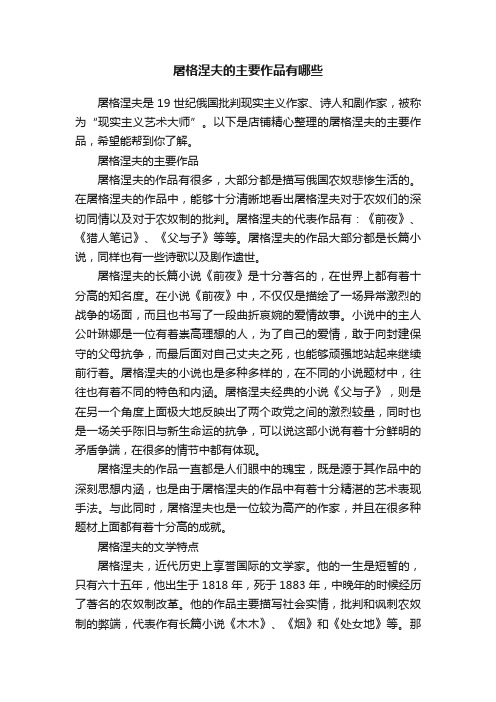
屠格涅夫的主要作品有哪些屠格涅夫是19世纪俄国批判现实主义作家、诗人和剧作家,被称为“现实主义艺术大师”。
以下是店铺精心整理的屠格涅夫的主要作品,希望能帮到你了解。
屠格涅夫的主要作品屠格涅夫的作品有很多,大部分都是描写俄国农奴悲惨生活的。
在屠格涅夫的作品中,能够十分清晰地看出屠格涅夫对于农奴们的深切同情以及对于农奴制的批判。
屠格涅夫的代表作品有:《前夜》、《猎人笔记》、《父与子》等等。
屠格涅夫的作品大部分都是长篇小说,同样也有一些诗歌以及剧作遗世。
屠格涅夫的长篇小说《前夜》是十分著名的,在世界上都有着十分高的知名度。
在小说《前夜》中,不仅仅是描绘了一场异常激烈的战争的场面,而且也书写了一段曲折哀婉的爱情故事。
小说中的主人公叶琳娜是一位有着崇高理想的人,为了自己的爱情,敢于向封建保守的父母抗争,而最后面对自己丈夫之死,也能够顽强地站起来继续前行着。
屠格涅夫的小说也是多种多样的,在不同的小说题材中,往往也有着不同的特色和内涵。
屠格涅夫经典的小说《父与子》,则是在另一个角度上面极大地反映出了两个政党之间的激烈较量,同时也是一场关乎陈旧与新生命运的抗争,可以说这部小说有着十分鲜明的矛盾争端,在很多的情节中都有体现。
屠格涅夫的作品一直都是人们眼中的瑰宝,既是源于其作品中的深刻思想内涵,也是由于屠格涅夫的作品中有着十分精湛的艺术表现手法。
与此同时,屠格涅夫也是一位较为高产的作家,并且在很多种题材上面都有着十分高的成就。
屠格涅夫的文学特点屠格涅夫,近代历史上享誉国际的文学家。
他的一生是短暂的,只有六十五年,他出生于1818年,死于1883年,中晚年的时候经历了著名的农奴制改革。
他的作品主要描写社会实情,批判和讽刺农奴制的弊端,代表作有长篇小说《木木》、《烟》和《处女地》等。
那么屠格涅夫的文学特点是什么呢?屠格涅夫的文学特点要在他作品的字句中寻找,他的作品非常多,涉及诗歌、小说、戏剧,但不论是哪种文学作品,无一不有他独具一格的特点。
俄国19世纪批判现实主义作家、诗人和剧作家伊凡·谢尔盖耶维奇·屠格涅夫
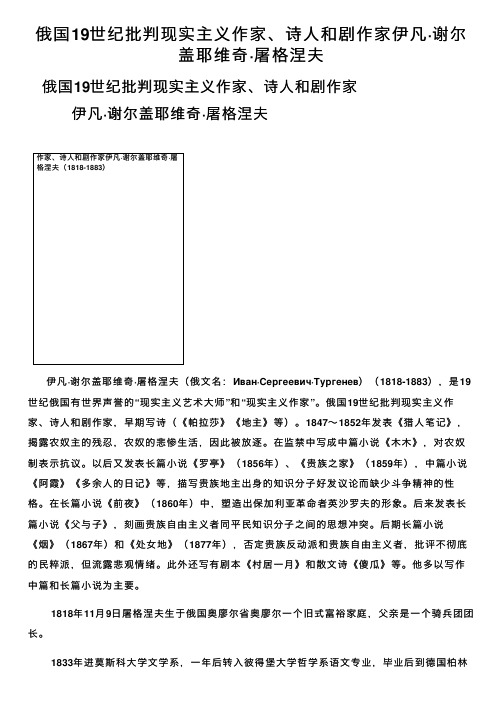
俄国19世纪批判现实主义作家、诗⼈和剧作家伊凡·谢尔盖耶维奇·屠格涅夫俄国19世纪批判现实主义作家、诗⼈和剧作家伊凡·谢尔盖耶维奇·屠格涅夫作家、诗⼈和剧作家伊凡·谢尔盖耶维奇·屠格涅夫(1818-1883)伊凡·谢尔盖耶维奇·屠格涅夫(俄⽂名:Иван·Сергеевич·Тургенев)(1818-1883),是19世纪俄国有世界声誉的“现实主义艺术⼤师”和“现实主义作家”。
俄国19世纪批判现实主义作家、诗⼈和剧作家,早期写诗(《帕拉莎》《地主》等)。
1847~1852年发表《猎⼈笔记》,揭露农奴主的残忍,农奴的悲惨⽣活,因此被放逐。
在监禁中写成中篇⼩说《⽊⽊》,对农奴制表⽰抗议。
以后⼜发表长篇⼩说《罗亭》(1856年)、《贵族之家》(1859年),中篇⼩说《阿霞》《多余⼈的⽇记》等,描写贵族地主出⾝的知识分⼦好发议论⽽缺少⽃争精神的性格。
在长篇⼩说《前夜》(1860年)中,塑造出保加利亚⾰命者英沙罗夫的形象。
后来发表长篇⼩说《⽗与⼦》,刻画贵族⾃由主义者同平民知识分⼦之间的思想冲突。
后期长篇⼩说《烟》(1867年)和《处⼥地》(1877年),否定贵族反动派和贵族⾃由主义者,批评不彻底的民粹派,但流露悲观情绪。
此外还写有剧本《村居⼀⽉》和散⽂诗《傻⽠》等。
他多以写作中篇和长篇⼩说为主要。
1818年11⽉9⽇屠格涅夫⽣于俄国奥廖尔省奥廖尔⼀个旧式富裕家庭,⽗亲是⼀个骑兵团团长。
1833年进莫斯科⼤学⽂学系,⼀年后转⼊彼得堡⼤学哲学系语⽂专业,毕业后到德国柏林⼤学攻读哲学、历史和希腊与拉丁⽂。
屠格涅夫进⼊莫斯科⼤学学习Su3673【1968.10.20】“俄国作家屠格涅夫诞⽣150周年”1全《屠格涅夫肖像》⼀年,随后转⼊圣彼得堡⼤学学习经典著作,俄国⽂学和哲学。
1838年前往柏林⼤学学习⿊格尔哲学。
列夫托尔斯泰哲理名言
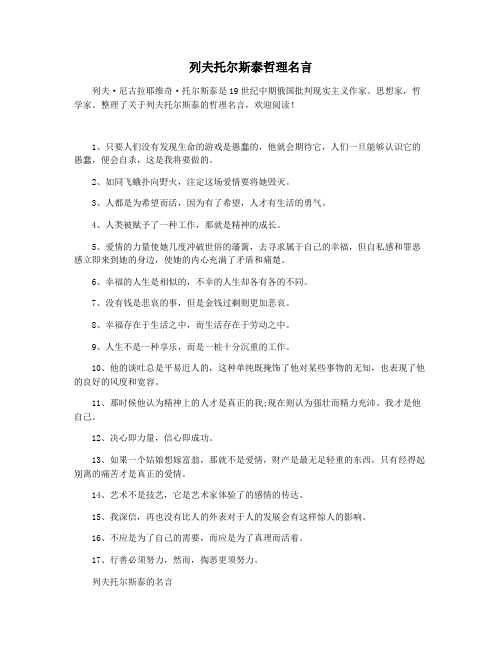
列夫托尔斯泰哲理名言列夫·尼古拉耶维奇·托尔斯泰是19世纪中期俄国批判现实主义作家、思想家,哲学家。
整理了关于列夫托尔斯泰的哲理名言,欢迎阅读!1、只要人们没有发现生命的游戏是愚蠢的,他就会期待它,人们一旦能够认识它的愚蠢,便会自杀,这是我将要做的。
2、如同飞蛾扑向野火,注定这场爱情要将她毁灭。
3、人都是为希望而活,因为有了希望,人才有生活的勇气。
4、人类被赋予了一种工作,那就是精神的成长。
5、爱情的力量使她几度冲破世俗的藩篱,去寻求属于自己的幸福,但自私感和罪恶感立即来到她的身边,使她的内心充满了矛盾和痛楚。
6、幸福的人生是相似的,不幸的人生却各有各的不同。
7、没有钱是悲哀的事,但是金钱过剩则更加悲哀。
8、幸福存在于生活之中,而生活存在于劳动之中。
9、人生不是一种享乐,而是一桩十分沉重的工作。
10、他的谈吐总是平易近人的,这种单纯既掩饰了他对某些事物的无知,也表现了他的良好的风度和宽容。
11、那时候他认为精神上的人才是真正的我;现在则认为强壮而精力充沛、我才是他自己。
12、决心即力量,信心即成功。
13、如果一个姑娘想嫁富翁,那就不是爱情,财产是最无足轻重的东西,只有经得起别离的痛苦才是真正的爱情。
14、艺术不是技艺,它是艺术家体验了的感情的传达。
15、我深信,再也没有比人的外表对于人的发展会有这样惊人的影响。
16、不应是为了自己的需要,而应是为了真理而活着。
17、行善必须努力,然而,掏恶更须努力。
列夫托尔斯泰的名言18、幸福的人都是一样的,不幸的人各有各的不幸。
19、由此可知,上帝是一个禁欲主义者。
他不允许别人干他不喜欢的事,因此他又是一个独裁主义者。
20、他身上发生的这一系列可怕的变化,原因仅仅是他不再相信自己,转而去相信别人。
至于他不再相信自己,而去相信别人的原因,那是因为如果相信自己,生活就会变得过于困难:相信自己,意味着处理各种问题都不能考虑追求轻松快乐的ròu tǐ的自我,而且几乎总是同他作对;相信别人,意味着无需处理任何问题,所有的问题都已经得到解决,解决问题的原则总是不考虑精神的自我,而只考虑ròu tǐ的自我。
列夫托尔斯泰英文简介
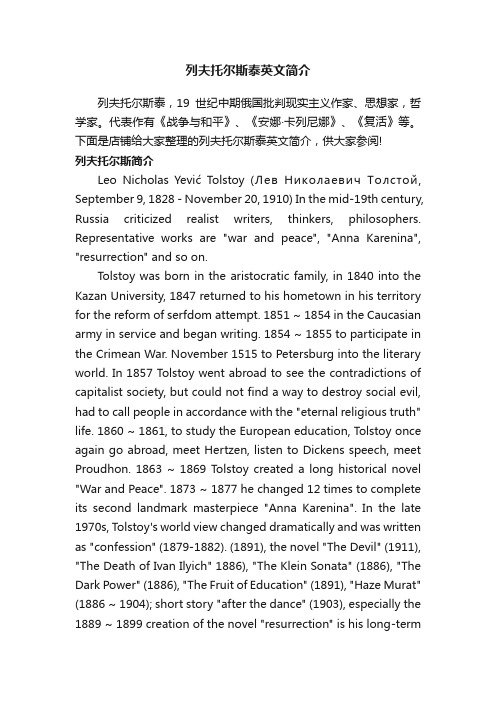
列夫托尔斯泰英文简介列夫托尔斯泰,19世纪中期俄国批判现实主义作家、思想家,哲学家。
代表作有《战争与和平》、《安娜·卡列尼娜》、《复活》等。
下面是店铺给大家整理的列夫托尔斯泰英文简介,供大家参阅!列夫托尔斯简介Leo Nicholas YevićTolstoy (ЛевНиколаевичТолстой, September 9, 1828 - November 20, 1910) In the mid-19th century, Russia criticized realist writers, thinkers, philosophers. Representative works are "war and peace", "Anna Karenina", "resurrection" and so on.Tolstoy was born in the aristocratic family, in 1840 into the Kazan University, 1847 returned to his hometown in his territory for the reform of serfdom attempt. 1851 ~ 1854 in the Caucasian army in service and began writing. 1854 ~ 1855 to participate in the Crimean War. November 1515 to Petersburg into the literary world. In 1857 Tolstoy went abroad to see the contradictions of capitalist society, but could not find a way to destroy social evil, had to call people in accordance with the "eternal religious truth" life. 1860 ~ 1861, to study the European education, Tolstoy once again go abroad, meet Hertzen, listen to Dickens speech, meet Proudhon. 1863 ~ 1869 Tolstoy created a long historical novel "War and Peace". 1873 ~ 1877 he changed 12 times to complete its second landmark masterpiece "Anna Karenina". In the late 1970s, Tolstoy's world view changed dramatically and was written as "confession" (1879-1882). (1891), the novel "The Devil" (1911), "The Death of Ivan Ilyich" 1886), "The Klein Sonata" (1886), "The Dark Power" (1886), "The Fruit of Education" (1891), "Haze Murat" (1886 ~ 1904); short story "after the dance" (1903), especially the 1889 ~ 1899 creation of the novel "resurrection" is his long-termthinking, art exploration to sum up. T olstoy tried to live a simple civilian life in his later years, and ran from home in October 1910. He died at a small station on August 7 at the age of 82.列夫托尔斯人物经历Early experienceTolstoy origin aristocrat, 1 year old and half maternal, 10-year-old father died, he was raised by the relatives of the family. In 1845 admitted to Kazan University Oriental language department, studying in Turkey, Arabic, mid-term exam failed, the second year to the law department. He does not concentrate on his studies, but also has a strong interest in philosophy, especially philosophy of morality, loves Rousseau's doctrine and its man, and reads literature extensively. In April 1847 the school was set up for the children of the peasants. November in the name of the administrative office in the province of Tula, the following year in December was promoted to fourteen civilian. In 1851 Tolstoy and his brother went to the Caucasian soldier. In 1852 he participated in a battle, the performance of brave, and published the novel "childhood".In 1853 Tolstoy read Turgenev's "hunter notes", very admired. In 1854 Tolstoy was transferred to the Danube front, and participated in the Crimean war in the Sevastopol city siege war, written as "juvenile", "youth" and "Sevastopol story set."In November 1855 Tolstoy left the army back to St. Petersburg, re-enter the entertainment circle, alcoholism gambling. The extreme personality led him to a 17-year break with Turgenev.Early creationTolstoy began writing in the Caucasus, in the "modern" magazine on the "Sevastopol story" and other novels. InNovember 1855 he came to Petersburg and was welcomed by Turgenev and Niek Lausov and others, and met Gonzalov, Fett, Ostrovsky, Druidin, Kov, Bautenge and other writers and critics. Tolstoy tends to Drew Rinin and others, but that any art can not be divorced from social life. In 1859, he broke with the "modern" magazine. At the end of 1856, the lieutenant was retired. The following year to France, Switzerland, Italy and Germany travel.In 1856 he drafted the plan, ready to lease the landlord and other methods to liberate the farmers, and in their own manor trial. 1860 due to the death of the long brother Nicholas, more deep pessimism. Between 1859 and 1862, almost half of the school was created, and more than 20 schools were run for the peasant children in the suburbs of Aznaya Poliana and the nearby villages. They studied the educational system in Russia and Western Europe. In 1860-1861, they also went to Germany, France, Italy, the United Kingdom and Belgium and other countries to study schools. And then founded the "Yasneria Poliana" and other educational journals. When he went out in July 1862, he was searched by the gendarmerie for two consecutive days. Soon he closed the school.In 1862 Tolstoy married the 17-year-old Sofia Andreiyevna Tolstoya (СофьяАндреевна Толстая), and Sonia was the daughter of the Czar's physician, who had 13 children before and after. His relationship with his wife is still controversial, it can be confirmed that most of the time they live well, his wife to help him manage the manor, which makes Tolstoy can be used for the full time of literary works of carved, Here, Tolstoy left mankind for "war and peace", "Anna Karenina" and other handed down for. Each of his works has to be modified many times, and his wife has also carried out the work of transcribing and preserving themanuscript.After the wedding, the revolutionary situation gradually into a low tide, he gradually overcome the ideological crisis. He is divorced from social, living in the estate, the purchase of industry, living a frugal, quiet, harmonious and happy life. From 1863 he was written in six years as a masterpiece "war and peace". In 1866 he attended the military court to defend the soldier Sibinin. Hebron was slap in the face of an indecisive officer's abuse, and although it was run by Tolstoy, Hebron was finally shot. This incident made him begin to form a view against the court and the death penalty.Change of mindSeptember 1869 due to the way through the Arzanas, late at night in the hotel suddenly felt a never had sadness and terror. This is the so-called "Alzanas horror". In the autumn of 1868 to the summer of 1869, he was interested in Schopenhauer's philosophy and was affected. From the early 1970s, he began a new ideological crisis and a new period of exploration. He studied various philosophical and religious books and could not find the answer. These thoughts and emotions in the creation of the "Anna Karenina" in a clear reflection. He visits the priests, the bishops, the monks and the monks, and acquiesns the peasant, the independent believer, He finally denied the official church, accepted the patriarchal peasant faith.Finally, under the influence of the new revolutionary situation and the famine of the whole nation in the 1970s and 1980s, the class was rejected, and the transformation of the world outlook, which began in the 1960s, was completed and transferred to the position of the patriarchal peasants. In the "Confessions" (1879 ~ 1880) and other papers, he extensively expounded the process oftheir ideological transformation. However, he opposed the violent revolution, to promote Christian love and self-cultivation, from the religion, ethics to find a solution to social contradictions. Torres is rich in originality. From then on Tolstoy to abandon their own and the surrounding aristocratic life, from time to time to engage in physical labor, their own land, sewing shoes, farmers for the house, exclusion of luxury, vegetarian vegetarian. He also changed the view of literature and art, denounced his past works of art, including "war and peace" and other masterpiece as "master-style game", and the focus shifted to the thesis and political theory to directly promote their own society, philosophy, religion Point of view, exposing the sovereign bourgeois society of all kinds of evil. At that time writing the script, short stories and folk tales, the same for this purpose. He also engaged in a wide range of social activities: in 1881 the daughter of the family moved to Moscow, he visited the slums, to participate in the 1882 Moscow census, in-depth understanding of the city's lower life; in 1881 he went to Alexander III, asked to forgive the throne of Alexander II revolutionaries The 1891 wrote to the editorial office of the Russian News and the New Era, declaring that the copyright of the works he wrote after 1881 was abandoned; in 1891-1893 and 1898, the victims of the relief of Liangzan and Tula provinces were organized He also tried to uphold the murder of the Morocho and Duhobauers by the official churches, and in 1898 decided to revive the "resurrection" of all royalties to the Duhuo Bauer moved to Canada.From the mid-1990s onwards, Tolstoy has enhanced the critical attitude towards social reality, and has often been skeptical about his propaganda of fraternity and anti-evil thoughts. This is reflected in the works of "Haze - Murat". Thetsarist government had long attempted to imprison or exile with his "famine" article, but was deterred by his reputation and public opinion. At this point because of "resurrection" published, accused him against God, do not believe in the world, in 1901 to the Russian Orthodox Church in the name of the Holy Spirit to remove his teachings. This decision caused the protests of the world, Tolstoy was at ease. In the same year he wrote "to the tsar and his assistants" by the tsarist government crackdown on the student movement; the following year sent a letter to Nicolas II calling for the freedom of the people and the abolition of the private ownership of the land. In 1904, he was opposed to the Russo-Japanese War. He sympathized with the revolutionaries and welcomed the coming of the revolution, but did not understand and avoid the 1905 revolution. And after the failure of the revolution, he opposed the tsarist government to kill the revolution, write "I can not be silent" article.Old ageTolstoy in the world view after the transformation, in 1882 and 1884 years have never wanted to run away from home. This intention is reflected in his creation in the 1980s and 1990s. In the last few years of his life, he realized that the awakening of the peasantry, because of their distance from their emotions and can not help but pessimistic disappointment; on their own landlord manor lifestyle is not consistent with the belief and feel uneasy. The dispute between his believers, Tolstoyism and his wife, made him so deep.Before Tolstoy left home, his break with his wife was well known. One night, the couple had trouble. After that, Tolstoy's wife had knelt down and pleaded with Tolstoy for her to read the poems and essays she had created herself for her early years tofind the sweetness of herself, but Tolstoy was dead. Finally, he left secretly from Yasneria Poliana on October 28, 1910. In the way of suffering from pneumonia, November 7 (Gregorian calendar on November 20) died at the Astapalo station. In accordance with his last words, the body buried in the forest of Azayana Poliana. There is no tombstone and cross on the grave.列夫托尔斯创作特点Theme of the workTolstoy in the novel on the human nature of a lot of thinking, from these thinking can be seen in the real world of Tolstoy's spiritual world, Tolstoy's thinking of human nature by the Russian history and reality inspired by the time On the one hand, the traditional Russian is the patriarchal society, the Orthodox determines the way people thought and feelings, Tolstoy is also affected by the Orthodox, regardless of his attitude is accepted or retained; the other hand, the European The spirit of the Enlightenment also deeply influenced Russia, which largely shook the foundation of the Russian tradition, and the influence of the Enlightenment on Tolstoy was remarkable, which made Tolstoy suspicion of the basic doctrines of the Orthodox Church , He does not think about believing as a general believer. However, Tolstoy did not completely move towards the European individualistic enlightenment position, so his thinking about human nature is often free between the two, sometimes like a believer, sometimes like a humanist.Tolstoy's works have utopian ideas, mainly for the anti-Hangzhou violence and enslavement, against the land private system, against the advocacy of capitalist material and "evolution", requires the pursuit of legitimate life obligations and reasonable laws of life, return to health Of the farming life,through all the labor and moral practice to establish a brotherhood, equality, harmony, fraternity belongs to the whole human world "heaven".Artistic characteristicsTolstoy created epic novels. The fact of history combines the imagination of art, unrestrained brushwork and delicate description; in the huge group of images show a personal face, epic solemnly interspersed with lyrical monologue, change thousands of wonders. He is good at harnessing the structure of the multi-clue, a multitude of things, convergence seamless; but also break through the novel "closed" form, magnificent, like life without beginning or end.Tolstoy's artistic charm, not only to reproduce the macro world, but also to describe the microscopic world. In the world literature in an unprecedented grasp of the dialectical development of the mind, meticulous description of the psychological changes in the outside world under the influence of the process; and deep subconscious, it is expressed in the relationship between mutual understanding and harmony. Tolstoy's artistic power is real, it is manifested in character shaping. Truthfully depicting the multifacetedness, abundance and complexity of the inner heart, not only to write a prominent state or predominant state of mind. Not conceal the shortcomings of the characters, do not choke the eyes of the people exposed the flash of light. Not exaggerated, not exaggerated, not idealized or comic, always with the real objective of the description, to show its true colors, which in the ordinary see great, or on the contrary, in the ordinary phenomenon shows its terrible. Depict the development and change of character, natural muddy and not reveal the traces ofax.Tolstoy's style is characterized by simplicity. And strive to the most full and most true reflection of the real life or expression of their own ideas, therefore, although the art of demanding, but not simply to win the skills, not the pursuit of formal exquisite, do not avoid the lengthy compound sentence, The greatest expressive force.In his later years, in the psychological analysis to make concise, do not write the whole process of experience, only to write the psychological process of the various stages of the main link; sometimes take the play method, through action and dialogue to show. Do not write the order of the development process, and write a sudden change caused by a sudden accident. In the structure, in order to show the awakening of characters, often using flashback method; in order to focus, the novel is no longer with more clues, and gradually expand the way with a single clue. In the language, then strive to simple and concise and easy to understand, close to folk tales.。
列夫托尔斯泰的作品列夫托尔斯泰三大巨著

列夫托尔斯泰的作品列夫托尔斯泰三大巨著列夫·尼古拉耶维奇·托尔斯泰(Лев Николаевич Толстой,1828年9月9日-1910年11月20日)19世纪中期俄国批判现实主义作家、文学家、思想家,哲学家。
世袭伯爵,曾参加克里米亚战争。
下面是分享的列夫托尔斯泰三大巨著。
供大家参考!列夫托尔斯泰三大巨著列夫.托尔斯泰(1828-1910),全名列夫.尼古拉耶维奇.托尔斯泰,十九世纪后半期俄国最伟大的作家,也是世界文学巨人之一。
托尔斯泰的世界观是充满矛盾的,他一方面对腐朽的沙皇专制制度充满憎恶和鄙视,以极大的勇气去谴责和揭露,另一方面又用唯心史观去解释历史和社会,企图通过道德和宗教的感化来调和阶级矛盾。
托尔斯泰的一生,是苦苦探求俄国出路的一生,代表作《战争与和平》、《安娜?卡列尼娜》、《复活》是托尔斯泰的三大巨著,深刻揭露了俄国错综复杂的社会矛盾和急剧变化的历史状况,无情地揭露了贵族社会争权夺利的内幕,强烈的戏剧冲突,产生了巨大的道义谴责力量,是俄国文学史上的不朽之作。
《战争与和平》《战争与和平》是俄国作家列夫·尼古拉耶维奇·托尔斯泰的代表作品。
文本以极其简洁的文字,卓越的、令人惊叹的心理分析,生动、鲜活地描绘了俄罗斯文学史上最令人激动的一组人物形象。
整部作品构思宏伟、气势奔腾,有力地展示出了俄罗斯历史上最壮丽的一页——1812年卫国战争,展示出了战争前后俄罗斯波澜壮阔的社会生活画卷。
作者将“战争”与“和平”的两种生活、两条线索交叉描写,构成一部百科全书式的壮阔史诗。
《安娜·卡列尼娜》《安娜·卡列尼娜》是俄国著名作家列夫·托尔斯泰的代表作品,在19世纪的世界文坛堪称首屈一指的优秀作品。
本书通过女主人公安娜的追求爱情悲剧,和列文在农村面临危机而进行的改革与探索这两条线索,描绘了俄国从莫斯科到外省乡村广阔而丰富多彩的图景,先后描写了150多个人物,是一部社会百科全书式的作品。
列夫 托尔斯泰

• 轮到他们走到米勒太太面前的时候,小列夫告诉 她他是谁,又和她提起了有关玻璃球的往事。米 勒太太拉着我的手来到棺材旁边,说:"那三个离 开的年轻人就是当年我跟你说起过的三个男孩。 他们刚才告诉我自己是多么感激吉米和他们做的' 交换'。现在,因为吉米已经不能再改变主意不要 不喜欢的玻璃球了---他们就来'还债'了。" "我们从来没有发过财,"她接着说,"但现在,吉 米可以自豪地说他是这个社区里最富有的人。"然 后她轻轻抬起丈夫的右手。我吃惊地发现手里握 着三颗精致的闪着亮光的红色玻璃球!
• 晚年是托尔斯泰对现实社会关系地各种观 点起了极大地变化,他憎恶贵族,同情劳 动人民,而妻子和儿女们却竭力要他保持 贵族地特权。他与妻女地感情破裂了。 1910年10月28日,他带了很少地衣物离家 出走了 。(见优化)
表现了他憎恶贵族,同情劳动人民且十分执着。
不仅爱好写作,而且爱好运动!
•
一天,当列夫先生帮别人把土豆装到袋子里的时候,他注意到一个小男孩正贪婪地盯 着一篮新摘下来的豌豆。男孩身体瘦削,穿着打补丁但很干净的衣服。他付了土豆的 钱,但也被新鲜的豌豆吸引,因为他非常喜欢奶油豌豆加土豆的滋味。在那人考虑是 否买豆子时,听到了列夫先生和男孩的谈话。 "你好,列夫,今天过得怎么样?" "很好,米勒先生,谢谢。这些豌豆看起来真棒。" "确实很好,列夫,你妈妈好吗?" "还好,比过去精神多了。" "你不想带回点豆子吗?"
"不了,先生,我没有钱。"
"嗯,那你有什么东西做交换吗?" "只有一颗赢来的玻璃球。" "是吗?让我看看。" "给你,它很漂亮。" "嗯,只是我想要一颗红色的玻璃球,而不是蓝色的。你有红色的吗?" "好像没有……不过,下次很可能会赢一个。"
列夫托尔斯泰主要内容概括

列夫托尔斯泰主要内容概括
列夫·托尔斯泰是19世纪中期俄国批判现实主义作家、政治思想家、哲学家,代表作有《战争与和平》《安娜·卡列尼娜》《复活》等。
他的独特的外貌特征和深邃的精神世界被奥地利作家茨威格描绘得淋漓尽致。
在《列夫·托尔斯泰》这篇文章中,茨威格用他力透纸背而又妙趣横生的文笔为我们描绘出一幅世界级大文豪托尔斯泰的“肖像画”,揭示出托尔斯泰深邃而卓越的精神世界。
全文在结构上由两个部分组成。
第一部分(第1~5段)刻画托尔斯泰的外貌特征。
第1段主要写托尔斯泰的须发的特点;第2段描写托尔斯泰的面部轮廓、结构;第3段进一步刻画托尔斯泰的面部特征,重点描写其面容表情;第4段写托尔斯泰长相平平,是俄国普通大众的一员。
第二部分(第6~9段)描写托尔斯泰那非同寻常的眼睛。
在19世纪下半叶的俄国,阶级矛盾空前尖锐,人民生活困苦不堪。
许多进步作家被陷害、监禁或流放。
而列夫·托尔斯泰却用他犀利的笔锋解剖和批判了那个病态的社会。
总的来说,《列夫·托尔斯泰》这篇文章不仅为我们展现了这位伟大作家的形象,同时也反映了19世纪俄国社会的现实和矛盾。
俄国杰出的批判现实主义作家图格涅夫
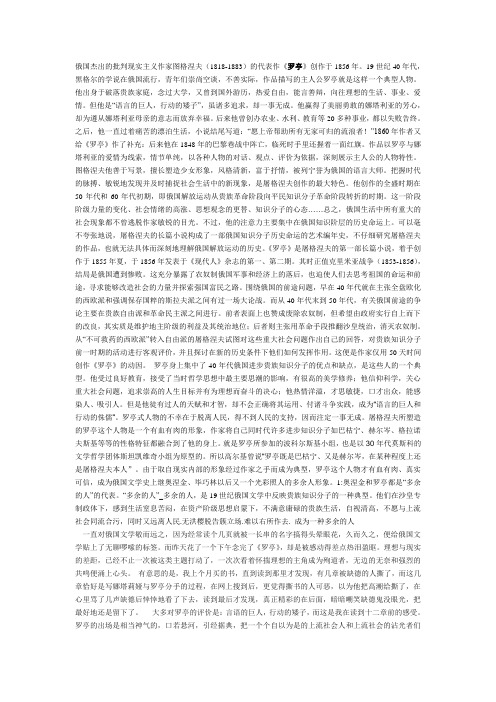
俄国杰出的批判现实主义作家图格涅夫(1818-1883)的代表作《罗亭》创作于1856年。
19世纪40年代,黑格尔的学说在俄国流行,青年们崇尚空谈,不善实际,作品描写的主人公罗亭就是这样一个典型人物。
他出身于破落贵族家庭,念过大学,又曾到国外游历,热爱自由,能言善辩,向往理想的生活、事业、爱情。
但他是“语言的巨人,行动的矮子”,虽诸多追求,却一事无成。
他赢得了美丽勇敢的娜塔利亚的芳心,却为遵从娜塔利亚母亲的意志而放弃幸福。
后来他曾创办农业、水利、教育等20多种事业,都以失败告终。
之后,他一直过着痛苦的漂泊生活,小说结尾写道:“愿上帝帮助所有无家可归的流浪者!”1860年作者又给《罗亭》作了补充:后来他在1848年的巴黎巷战中阵亡,临死时手里还握着一面红旗。
作品以罗亭与娜塔利亚的爱情为线索,情节单纯,以各种人物的对话、观点、评价为依据,深刻展示主人公的人物特性。
图格涅夫他善于写景,擅长塑造少女形象,风格清新,富于抒情,被列宁誉为俄国的语言大师。
把握时代的脉搏、敏锐地发现并及时捕捉社会生活中的新现象,是屠格涅夫创作的最大特色。
他创作的全盛时期在50年代和60年代初期,即俄国解放运动从贵族革命阶段向平民知识分子革命阶段转折的时期。
这一阶段阶级力量的变化、社会情绪的高涨、思想观念的更替、知识分子的心态……总之,俄国生活中所有重大的社会现象都不曾逃脱作家敏锐的目光。
不过,他的注意力主要集中在俄国知识阶层的历史命运上。
可以毫不夸张地说,屠格涅夫的长篇小说构成了一部俄国知识分子历史命运的艺术编年史,不仔细研究屠格涅夫的作品,也就无法具体而深刻地理解俄国解放运动的历史。
《罗亭》是屠格涅夫的第一部长篇小说,着手创作于1855年夏,于1856年发表于《现代人》杂志的第一、第二期。
其时正值克里米亚战争(1853-1856),结局是俄国遭到惨败。
这充分暴露了农奴制俄国军事和经济上的落后,也迫使人们去思考祖国的命运和前途,寻求能够改造社会的力量并探索强国富民之路。
列夫尼克拉耶维奇托尔斯泰是19世纪伟大的批判现实...

其实, 其实,托尔斯泰的墓只是一个长方形的土 堆而已,无人守护, 堆而已,无人守护,坟墓外围了一圈低矮 的小栅栏,就连10岁大的孩子都可以跨过 的小栅栏,就连 岁大的孩子都可以跨过 坟上长满了绿草, 去,坟上长满了绿草,甚至没有修剪过的 痕迹。 痕迹。附近几株大树荫蔽着这个伟大文豪 长眠的地方。 长眠的地方。只是在接近坟附近的区域写 了一个“肃静”的俄文牌子, 了一个“肃静”的俄文牌子,以及坟上瞻 仰者敬献的一束白花才表明这是一块坟地。 仰者敬献的一束白花才表明这是一块坟地。
波良纳庄园, 波良纳庄园,那里是俄 俄罗斯首都莫斯科向西南 罗斯大文豪列夫托尔 驱车200多公里,便可到 多公里, 罗斯大文豪列夫 托尔 驱车 多公里 斯泰的故乡, 斯泰的故乡,既是他的 达中俄罗斯高地的一座城 图拉。 市 图拉 诞生地,又是他的墓地。 诞生地,又是他的墓地。 ——图拉。从图拉出来 正是由于托尔斯泰, 再走10几公里就到了著名 正是由于托尔斯泰,亚 再走 几公里就到了著名 斯纳亚-波良纳也成为 亚斯纳亚波良纳庄园 波良纳庄园— 斯纳亚 波良纳也成为 的亚斯纳亚 波良纳庄园 了世界上为数不多的文 俄罗斯大文豪托尔斯泰的 化圣地之一。 庄园。 化圣地之一。 庄园。
罗曼罗兰写的《三巨人传》 罗曼罗兰写的《三巨人传》中的三 巨人指的就是贝多芬、 巨人指的就是贝多芬、米开朗其罗 和列夫尼克拉耶维奇 托尔斯泰。 尼克拉耶维奇托尔斯泰 和列夫 尼克拉耶维奇 托尔斯泰。 罗曼罗兰说 罗兰说, 战争与和平》 罗曼 罗兰说,《战争与和平》是 我们的时代最伟大的史诗, “我们的时代最伟大的史诗,是 近代的《伊利亚特》”。 近代的《伊利亚特》”。 陀思妥耶夫斯基十分推崇, 安娜卡列 陀思妥耶夫斯基十分推崇,称“《安娜 卡列 尼娜》 尼娜》是欧洲文坛上没有任何一部作品可以 与之相媲美的、白璧无瑕的艺术珍品。 与之相媲美的、白璧无瑕的艺术珍品。作者 本人是空前绝后的艺术大师” 本人是空前绝后的艺术大师”。 列宁: 复活》 使其“ 列宁:《复活》 使其“俄国革命的一面 镜子” 镜子”
《列夫·托尔斯泰》茨威格

生字新词
胡髭zī 长髯rán 脸颊jiá 黝黑yǒu 脸膛táng 一绺liǔ 鬈发quán 粗劣liè 滥造làn 藏污纳垢gòu 粗糙cāo 崎岖qí qū 粗鄙bǐ 忧郁yù 滞留zhì 愚钝dùn 穹顶qióng 禁锢gù愚昧mèi 郁郁寡欢guǎ 憎恨zēng 貂皮diāo 归宿sù 酒肆sì乡绅shēn 吻合wěn
烁烁发光shuò 匕首bǐ 戳进chuō
课文详解
第二段“天才的灵魂自甘 寓居低矮的陋屋”,“低 矮的陋屋”运用了什么修 辞手法?指什么? 借喻。指托尔斯泰平庸甚 至丑陋的面孔。
课文详解
课文详解
脉络梳理
主题归纳
本文运用大量的比喻和夸张, 通过对列夫·托尔斯泰外貌 的刻画,不仅展示了其独特 的外貌特征,更为我们揭示 了他深邃而卓越的精神世界, 表达了作者对列夫·托尔斯 泰的无限崇敬与赞美之情。
文化长廊 屠格涅夫
屠格涅夫,19世纪俄国批判现实 主义作家,主要作品为长篇小说 《罗亭》《父与子》《贵族之家》 《前夜》,中篇小说《木木》, 散文故事集《猎人笔记》。《猎 人笔记》的短篇描写农奴的悲惨 生活,抨击农奴制度,被誉为 “一部点燃火种的书”。
文化长廊 高尔基
高尔基,前苏联伟大的无产阶级作 家,前苏联社会主义文学奠基人。 主要作品为自传体三部曲《童年》 《在人间》《我的大学》,长篇小 说《母亲》,散文诗《海燕》等。 列宁称之为“无产阶级艺术的最杰 出代表”,称《母亲》是一部“非 常及时的书”。
生字新词
胡髭 长髯 脸颊 黝黑 脸膛 一绺 鬈发 粗劣 滥造 藏污纳垢 粗糙 崎岖 粗鄙 忧郁 滞留 愚钝 穹顶 禁锢 愚昧 郁郁寡欢 憎恨 貂皮 归宿 酒肆 乡绅 吻合 缰绳 敦实 侏儒 尴尬 灌木 犀利 锃亮 甲胄 剑鞘 和蔼 粲然 热泪涟涟 黯然 冷酷 意趣盎然 频波 胆怯 广袤无垠 烁烁发光 赤裸裸 匕首 戳进
《安娜卡列尼娜》经典长篇小说作品介绍
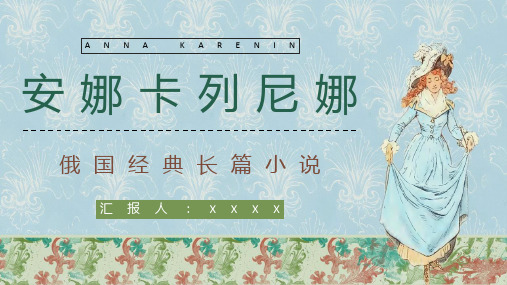
渥伦斯基毕业于贵族军官学校,后涉足于 莫斯科社交界,以其翩翩风度得到了多丽 的妹妹吉提的垂青,但他只与她调情,并 无意与她结婚。而深爱着吉提的康斯坦 丁·列文也从乡下来到莫斯科,他打算向吉 提求婚。
在他看到安娜的一刹那,那刻被安娜所俘 虏,他在薛杰巴斯大林基公爵家的舞会上, 向安娜大献殷勤。而吉提精心打扮想象着 渥伦斯基要正式向她求婚。吉提发现渥伦 斯基和安娜异常地亲热,这使她感到很苦 闷。
同渥伦斯基的相遇是安娜性格的转折 点,使她第一次领略到了她从来没有 体验过的爱情,认识到过去全部生活 的虚伪。于是,个性解放的激情冲破 了上流社会陈腐偏见的罗网,她喊出 了“我要爱,我要生活”的叛逆呼声, 并且不顾一切地同渥伦斯基结合了。 安娜以感情为第一生命,是个内心世 界丰富崇高的女性,有着极其崇高的 人格追求,浑身焕发着美丽的生命元 气和青春活力。
作者介绍
他创作了大量童话。他以自己一生的辛勤创作,登上了当时欧洲批判现实主义文学 的高峰。他还以自己有力的笔触和卓越的艺术技巧辛勤创作了“世界文学中第一流 的作品”,因此被列宁称颂为具有“最清醒的现实主义”的“天才艺术家”。 托尔斯 泰思想中充满着矛盾,这种矛盾正是俄国社会错综复杂的矛盾的反映,是一个富有 正义感的贵族知识分子在寻求新生活中,清醒与软弱、奋斗与彷徨、呼喊与苦闷的 生动写照。托尔斯泰的作品纵然其中有反动的和空想的东西,但仍不失为世界进步 人类的骄傲,他已被公认是全世界的文学泰斗。列夫·托尔斯泰被列宁称为“俄国革 命的镜子”
间的冲突。1877年,小说首版发行。它
2
的各个章节都引起了整个社会的“跷足”注
视,及无休无止的“议论、推崇、非难和
争吵,仿佛事情关涉到每个人最切身的
问题”。
1
《安娜·卡列尼娜》巨大的思想和艺
安娜 卡列尼娜 赏析
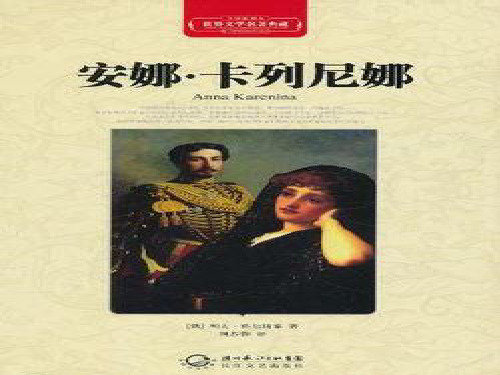
思想转变 1869年9月因事途经阿尔扎马斯,深夜 在旅馆中突然感到一种从未有过的忧愁 和恐怖。这就是所谓“阿尔扎马斯的恐 怖”。1868年秋至1869年夏,他对叔本 华哲学发生兴趣,一度受到影响。从70 年代初起,他开始新的思想危机和新的 探索时期。他研读各种哲学和宗教书籍, 不能找到答案。这些思想情绪在当时创 作的《安娜· 卡列尼娜》中得到鲜明的反 映。他访晤神父、主教、修道士和隐修 士,并结识农民、独立教徒康· 修塔耶夫。 他终于完全否定了官办教会,接受了宗 法制农民的信仰,最后在70至80年代之 交新的革命形势和全国性大饥荒的强烈 影响下,弃绝本阶级,完成了60年代开 始酝酿的世界观的转变,转到宗法制农 民的立场上。
19世纪中期俄国批判现实主义作家、文学 家、思想家,哲学家。世袭伯爵,曾参加 克里米亚战争。返回雅斯纳· 亚波利亚纳 的农庄后致力于农民教育。1862年结婚后, 创作了俄罗斯文学史上的巨著《战争与和 平》(1859~1869)、《安娜· 卡列尼娜》 (1875~1877)。1879年经历了一次信仰危 机后信奉和平主义,主张以勿抗恶的方式 对社会进行改革。并否定自己以前的作品。 因执着于自己的信念使家庭关系恶化,死 于出奔途中。其作品多达45卷。名著还有 长篇小说《复活》(1899)、戏剧《黑暗的 势力》(1886)和若干短篇小说和评论[1] 。 他的文学传统不仅通过高尔基而为苏联作 家所批判地继承和发展,在世界文学中也 有其巨大影响。在文学创作和社会活动中, 他提出了“托尔斯泰主义”,对很多政治 运动有着深刻影响。
从19世纪90年代中期开始,托尔斯泰增强 了对社会现实的批判态度,对自己宣传的 博爱和不抗恶思想也常常感到怀疑。这在 《哈泽—穆拉特》等作品中有所反映。沙 皇政府早就因他的《论饥荒》一文而企图 将他监禁或流放,但慑于他的声望和社会 舆论而中止。至此又因《复活》的发表, 指责他反对上帝,不信来世,于1901年以 俄国东正教至圣宗教院的名义革除他的教 籍。这个决定引起举世的抗议,托尔斯泰 却处之泰然。同年他因沙皇政府镇压学生 运动而写《致沙皇及其助手们一文》;次 年致函尼古拉二世要求给人民自由并废除 土地私有制;1904年撰文反对日俄战争。 他同情革命者,也曾对革命的到来表示欢 迎,但却不了解并回避1905年革命。而在 革命失败后,他又反对沙皇政府残酷杀害 革命者,写出《我不能沉默》一文。
选择性必修上册《复活》

《复活》内容介绍
小说女主人公卡秋莎·玛丝洛娃本是一个贵族地主家的女仆,她被主人的侄子、贵族 青年聂赫留朵夫公爵玩弄后遗弃。由此她陷入了苦难的生活,她怀着身孕被主人赶走,四 处漂泊,沦为妓女。后来她被人诬陷谋财害命而被捕入狱。小说男主人公聂赫留朵夫以 陪审员的身份出庭审理玛丝洛娃的案件。他认出了被告就是从前被他遗弃的玛丝洛娃, 他受到了良心的谴责。为了给自己的灵魂赎罪,他四处奔走为她减刑。当所有的努力都 无效时,玛丝洛娃被押送去西伯利亚,聂赫留朵夫与她同行。玛丝洛娃在聂赫留朵夫的真 诚忏悔和关怀下,消除前怨,重新唤醒内心的美德,并且为了他的前途,拒绝了他的求婚,与 政治犯西蒙松结合。男女主人公的经历,表现了他们在精神上和道德上的复活。小说揭 露和批判俄国社会的腐败和黑暗,批判了专制的国家制度,揭露了政府机关的黑暗和官吏 的残暴。
合作探究
活动1:分析情节 3.从文中看,玛丝洛娃的堕落是否自愿?原因是什么? 明确 她的堕落不是自愿的,而是被迫的。因为开始 的时候,聂赫留朵夫给她打开了一个充满感情和理想 的新奇天地,但是他后来的残酷给她带来了屈辱和苦 难,她感到痛苦,竭力用堕落生活来麻醉自己的灵魂。
合作探究
活动1:分析情节 4.聂赫留朵夫要用自己的行为对玛丝洛娃赎罪,这种想法是一以贯 之的,还是有过动摇? 明确 有过动摇,从聂赫留朵夫见到玛丝洛娃,并通过交谈认识到 自己的行为和对她造成的伤害而深深忏悔,决定用自己的行动赎罪。 但是看到玛丝洛娃问自己要钱,觉得她已经不是以前的玛丝洛娃时, 也进行过激烈的思想斗争,怕被她牵连,并想用金钱洗刷自己的罪 责,但随之又坚定了自己的想法,坚定了赎罪的决心。
合作探究
活动2:鉴赏语句 1.“这个女人已经丧失生命了”。 明确 这是来自聂赫留朵夫内心的一声喟叹。面前的玛丝 洛娃不再是自己曾经深爱的女孩儿----纯洁可爱的卡秋莎, 而是一个堕落、卖弄风骚、见钱眼开的粗俗女子,她丧失 的不是生理学上的生命,而是自己纯洁可爱的灵魂。
《复活》ppt
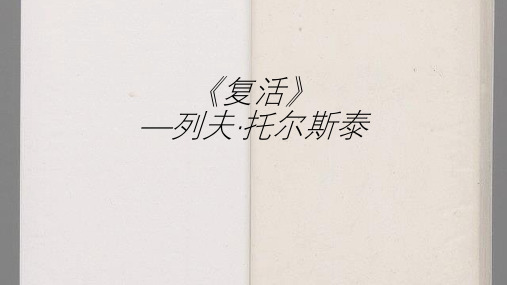
3.改良主义(空想):小说还从经济制度上探究了人民痛苦不幸的根源,否定了土地私有制,提出了要解 决农民与地主的矛盾必须把土地归还农民的看法。同时又宣扬了改良主义(空想)。
3.她处身于社会最下层,却又自认为高出于其他苦难人之上。 4.她天资聪颖,阅历丰富,能看清许多严酷的社会现象,识透上 层人物的丑恶灵魂。 纯洁美丽,善良厚道,乐观开朗,自暴自弃(聂赫留朵夫的凌 辱和社会的迫害。)
主题思想:
1.托尔斯泰主义:小说揭露了法律制度的虚伪和反人民的本质,批判了整个官僚机构,勾画了国家机构 中各级官吏的丑恶嘴脸。同时小说又大力宣传“不以暴力抗恶”、“道德自我完善”、宽恕和爱等一整套托 尔斯泰主义的思想。
• 1889~1899年创作的长篇小说《复活》是他长期思想、艺术探索 的总结
创作背景:
• 时代背景 • 19世纪70年代末到80年代初,俄国的资本主义迅猛发展,农村遭到巨大的破坏,广大劳动
人民的生活日趋赤贫。当时俄土战争的重负,连年饥馑给人民带来更为深重的灾难。这时 托尔斯泰越发地关心人民的困苦。他积极地参加当时的救灾工作,目睹了农民和城市贫民 的可怕处境,在他多年探索、思考的基础上终于看清了沙皇专制制度的反动本质。 [6] 作者 参加1891至1892年的赈灾工作,体会农民与地主之间有一条巨大的鸿沟,农民贫困的根源 是地主土地私有制。 • 个人背景 • 托尔斯泰在相继完成了巨著《战争与和平》、《安娜·卡列尼娜》之后,进入晚年的他世界 观发生了根本转变,他的艺术批判力量达到了高峰,达到了“撕毁一切假面具”的“清醒现实 主义”。这无疑是他艺术探索的结果,同时更是他精神探索的结果。以广大农民的眼光观察 俄国现实生活,代表农民阶级发表意见,这是他晚期创作巨大批判力量的主要源泉。这在 他的各种作品中,特别是长篇小说《复活》中表现得最鲜明、也最为突出。
- 1、下载文档前请自行甄别文档内容的完整性,平台不提供额外的编辑、内容补充、找答案等附加服务。
- 2、"仅部分预览"的文档,不可在线预览部分如存在完整性等问题,可反馈申请退款(可完整预览的文档不适用该条件!)。
- 3、如文档侵犯您的权益,请联系客服反馈,我们会尽快为您处理(人工客服工作时间:9:00-18:30)。
19世纪中期俄国批判现实主义作家、文学家、思想家,哲学家。
世袭伯爵,曾参加克里米亚战争。
返回雅斯纳·亚波利亚纳的农庄后致力于农民教育。
1862年结婚后,创作了俄罗斯文学史上的巨著《战争与和平》(1859~1869)、《安娜·卡列尼娜》(1875~1877)。
1879年经历了一次信仰危机后信奉和平主义,主张以勿抗恶的方式对社会进行改革。
并否定自己以前的作品。
因执着于自己的信念使家庭关系恶化,死于出奔途中。
其作品多达45卷。
名著还有长篇小说《复活》(1899)、戏剧《黑暗的势力》(1886)和若干短篇小说和评论[1]。
他的文学传统不仅通过高尔基而为苏联作家所批判地继承和发展,在世界文学中也有其巨大影响。
在文学创作和社会活动中,他提出了“托尔斯泰主义”,对很多政治运动有着深刻影响。
《穷人》是俄国著名作家列夫·托尔斯泰的作品。
当时,俄国劳动人民处于沙皇的黑暗统治之下,生活极度贫困,但是他们心地善良、情操高尚。
课文记叙了渔夫和她的妻子桑娜关心、同情邻居西蒙,在西蒙死后毅然收养了她的两个孩子的故事,反映了穷人纯朴善良的同情心和乐于助人的高尚品质。
作者通过桑娜一家的生活反映了那一时期穷苦人民的苦难生活和他们美好的心灵。
体现出在那样的困境中,桑娜一家崇高的心怀。
